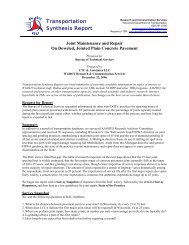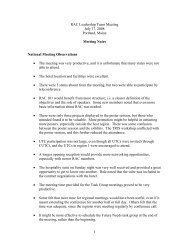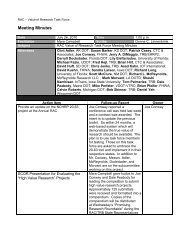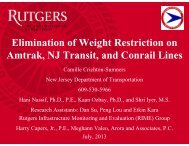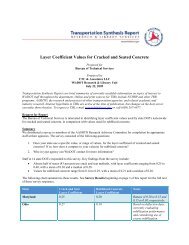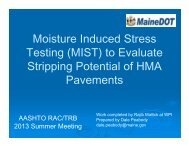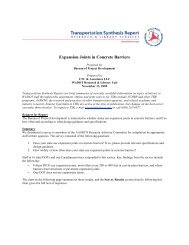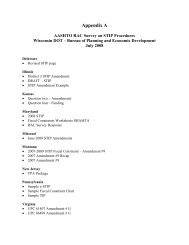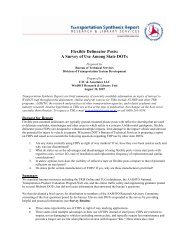PART IV: Summary of Comments - SCOR/RAC
PART IV: Summary of Comments - SCOR/RAC
PART IV: Summary of Comments - SCOR/RAC
You also want an ePaper? Increase the reach of your titles
YUMPU automatically turns print PDFs into web optimized ePapers that Google loves.
<strong>PART</strong> <strong>IV</strong>: <strong>Summary</strong> <strong>of</strong> <strong>Comments</strong>17-May-10Reviewer <strong>Comments</strong> Distribution <strong>of</strong> Ratings■ This has been an established research need for some time. This research need is a logical step in a series <strong>of</strong> ongoingresearch efforts dating back over ten years with the development <strong>of</strong> the AIMS device and all <strong>of</strong> the work done withICAR. This year AASHTO balloted a new test method for the AIMS device. Now the next question will be, what do wedo with this test information? This research statement appears to be the next and proper course <strong>of</strong> action. With thatbeing said, with the risk <strong>of</strong> expanding the scope, there should be at least some evaluation <strong>of</strong> RAP in regards to theaggregate properties being discussed in this research need statement. RAP <strong>of</strong>tentimes makes up a significant portion <strong>of</strong>the mixture, and the RAP properties are not well understood similar to the aggregate properties being evaluated in thisresearch.■ Has some merit. Other research does not have the details <strong>of</strong> this one. May only be the beginning.■ There is insufficient emphasis on the relationship between aggregate properties and pavement performance■ include RAP?■ Would like this study better if they didn't try to combine aggregate properties related to pavement performance and use <strong>of</strong>marginal materials. Just focus on aggregate properties related to pavement performanceOther■ [Rating: 3]■ [Rating: 1] The proposed research aims at developing quantitative relationship between the properties <strong>of</strong> aggregates andasphalt concrete measured in the laboratory and the in-service performance <strong>of</strong> the pavements.- The proposed topic has been addressed in an earlier NCHRP project and is being further investigated in a currentNCHRP project.- Extensive work on the subject has been done in the past or is underway; further research is unwarranted at this time.Item #107:G-10Retroreflectivity Standards for Transverse Markings(17)(46)NR 0 1 2 3 4 5<strong>SCOR</strong> 1 6 4 3 2 1<strong>RAC</strong> 4 15 9 7 11 3Standing Committee on Research■ I wonder how much information from longitudinal marking standards that go into effect this year can be applied totranverse markings. It makes sense to consider standards for transverese markings next. There is a need for this researchand this topic has high pay<strong>of</strong>f potential. Of particular importance are areas with high volumes <strong>of</strong> pedestrian traffic■ This is an important issue in California. Suggest adopting the same equipment and process currently used to determinelongitudinal marking visibility. After applying the test regime, identify the strengths and weaknesses <strong>of</strong> the currentprocess as applied to transverse markings and then, if needed, modify it accordingly.■ low need, limited scope■ Would be much more difficult for DOTs to maintain minimum retroreflectivities for transverse pavement markings, ascompared to long lines, due to the high wear caused by traffic. The research may be successful but difficult to implement.■ [Rating: 1] Transverse markings are supplementary, and are not the primary source <strong>of</strong> information to road users. Whileadequate retroreflectivity should be maintained, agencies can use the values recommended for longitudinal lines as aninitial requirement.Research Advisory Committee■ Transverse markings should not be treated differently when it comes to taking retro reflectivity readings. No explanationwas given why there is a need to distinguish between the readings <strong>of</strong> the markings. This Problem Statement is given a 1priority level rating.■ We think this is already available<strong>IV</strong>-78



